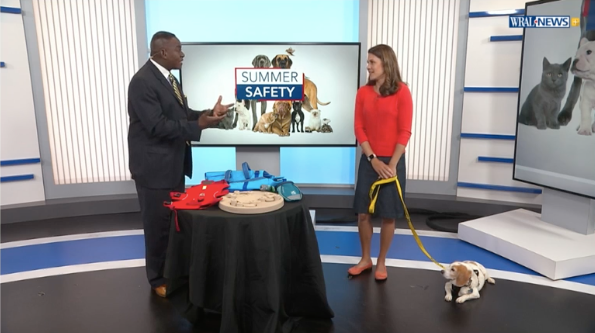Summer in North Carolina is my favorite time of year to enjoy the beach and find fun ways to still be outside without over-doing it in the heat. For our pets, the heat, bugs, and outdoor adventures can quickly become dangerous without the right precautions.
I recently had the chance to return to my former TV station, WRAL, for a segment on summer pet safety. Watch it here. I brought along a sweet, adoptable senior beagle named Leeloo from Triangle Beagle Rescue (and yes, she was a perfect little angel). We shared practical, pet-parent-tested ideas to help your dogs enjoy the season while staying safe. I also reached out to the team at Truss Vet – Veterinary Urgent Care for added expert insight and powerful reminders for pet families.

Here are the top takeaways for keeping your pets safe this summer:
Shorter walks, more indoor games
Unlike humans, dogs can’t sweat. They rely on panting and evaporation from their tongues too cool off
What I didn’t know…is that humidity can actually make it harder for dogs to cool down.
Veterinarian Dr. Brad Waffa with Truss Vet explains, “North Carolina has such high humidity this time of year though, which slows evaporation and makes this process less efficient.” So even if it’s not 99 degrees out, but the humidity is at higher levels, dogs still need help staying cool. Dr. Waffa adds that keeping cool can be even harder for dogs with short-snouts. “Another complicating factor: Brachycephalic airway syndrome. This refers to anatomical differences all smushy-faced dogs have to some degree that make it much more difficult for these breeds to cool themselves.
What to do: Many dogs need longer walks or a round of fetch to burn off their energy so they aren’t bored and turning to mischief at home. But during the heat of the summer, those walks and playtimes need to be cut short. They can still burn off mental energy with a few minutes practicing tricks, running stairs a few times, or using food puzzles. During my WRAL segment, Leeloo demonstrated her skills using an Outward Hound puzzle that we use with our pup.

Protect those paws
When it comes to summer pet safety advice, avoiding burned paws is at the top of the list. Hot pavement isn’t just uncomfortable, it can burn your dog’s paw pads. Early in the season, dogs who’ve been less active may have softer pads that are more prone to injury.
Vet insight: “Blacktop and concrete can become dangerously hot in the summertime, especially in direct sunlight… We often see paw pad injuries earlier in the season.” He also adds a warning about using protective booties. “If they’re not well-fitted these can cause blisters, chafing, or even cut off circulation.”
What to do: Use the “five-second rule”: if you can’t hold the back of your hand on the pavement for five seconds, it’s too hot for your dog’s paws. Stick to grass and shaded paths.
Snakes.
Copperheads are very common here in our Cary neighborhood and in North Carolina in general. I’m still shuddering at the time we had one crawling down our driveway around Halloween. Our neighbors just had a baby copperhead curled up in their garage last month. (I ran like a baby far far away). They are most active at dawn and dusk so put that phone down or use the flashlight on it to illuminate where you are walking.
Vet insight: “Most snakebites in our area are from copperheads which, fortunately, are not usually lethal. They can be deadly to some dogs though, and they’re extremely painful regardless, so pet owners should always seek immediate veterinary attention,” says Waffa.
What to do: Wear closed-toed shoes when walking your dog. Use the flashlight on your phone or grab on of these cool poop bag holder/flashlight combos I use when I walk Boone at night.
Water safety for dogs: know before they splash
North Carolina summers bring more time by the water. Whether your out on the pontoon boat at Jordan Lake or talking a hike at Umstead Park, be aware of increased risks. Toxic blue-green algae thrives in warm, stagnant ponds and lakes, and can be deadly if your dog drinks or licks it off their fur. Always bring clean water and avoid suspicious-looking areas.
Vet Insight: “We see an increased incidence of drownings, blue green algae toxicity, leptospirosis, and other water-related problems this time of year. This doesn’t mean we shouldn’t allow our dogs the chance to swim or explore; it just means we should ensure they’re up-to-date on their vaccinations, be thoughtful about where we take them to swim, and closely monitor them.”
What is blue green algae? It looks like spilled paint in the water. This youtube video is a great resource to show you how to do the “stick test” to see if it’s blue green algea. In short, if you can’t pick it up with a stick, avoid swimming in that area.
What do do: Avoid letting your dog swim in unfamiliar or stagnant bodies of water. Always bring clean drinking water so they don’t lap from questionable sources.If your dog doesn’t enjoy swimming, don’t force it. For water-loving pups, a properly fitted life jacket is essential, especially near boats or open water. Keep it fun and safe by following their lead and staying alert.

Prevention is always the best option
Make sure you are keeping up with your flea/tick prevention. Treating a dog for Heart worms can be very expensive and often a painful experience for dogs (if they get the injections). While they can make a great recovering and still live long lives, sparing your dog from this treatment is one of the best gifts you can give them.
Veterinarians also see a rise in kennel cough or Canine infectious respiratory disease during the summer. As more families travel and dogs are boarded, there is a great risk for the disease to spread. Your boarding facility should require a copy of your pet’s most recent vaccination and vet records before accepting your dog.
You also don’t want to drop your pup off on your way out of town only to find out he or she isn’t up to date on vaccinations and isn’t allowed to stay. (True story…we had a mix-up with our vet records one time and didn’t know until we were on a way to a wedding out of town. I ended up having to stay home with the dogs so my husband could still go celebrate his friend.)
Summer safety for cats (keep them cool indoors)
Summer safety isn’t just about dogs. Cats also face dangers during the summer months. It’s tempting to let your cat roam on nice days, but the risks far outweigh the freedom.
Vet insight: “Outdoor cats are at a profoundly increased risk for injury, disease, and early death. They’re also devastating to local ecosystems. Outdoor cats are also preyed upon by foxes, coyotes, and other wildlife, and they are also regularly hit by cars. We see more of these issues in the summer months due to increased outdoor activity, but they are year-round problems,” says. Dr. Waffa.
He also says that cats are experts at hiding their pain emotionally and physically. If your cat is bitten by a snake or injured in an encounter with another animal, they may not immediately show signs of pain. Their thick fur can also hide any puncture wounds which means once an infection takes place, it may be worse off due to the time between the injury and when the owner notices changes in their cat.
What to do: Create enriching indoor environments or try controlled outdoor access (like catios). Daily interaction with your cat also helps you spot any hidden wounds or illnesses early. If your cat really, really just can’t stand life without some outside time, consider training them on a leash to go for walks. I’ve had quite a few clients who have cats that enjoy leashed walks or being in their stroller.
Also check out this small business who specializes in building “Catios.” You can purchase blueprints and different plans to build a special oasis for your cats.

Don’t let busyness become a risk
Between vacations, summer camps, and back-to-school chaos, our schedules fill up fast, but our pets’ needs don’t pause.
Vet insight: “Our pets age faster than we do, so it’s important to see your primary care vet every 6–12 months,” reminds Dr. Waffa.
What to do: Make preventive care a priority. Schedule those wellness visits and double-check that your pet’s meds and vaccines are current. Also know where your nearest Urgent Care Vet Clinic is or emergency vet clinic.
Not sure when you need to go to Urgent Care or the Emergency Vet? Check out this great explanation by Truss Vet so you’ll know where to go in case of an accident. All those years in the news business and being a Girl Scout have me thinking about the “what ifs” and knowing where to go. Make sure you have the confidence to give your dogs and cats their best summer!
Thanks for sticking with me to the end!
If you found this helpful, share it with a fellow pet parent—because the only hot dogs you should see this summer are the ones at your next cookout. (#dadjokes…I couldn’t help myself)

